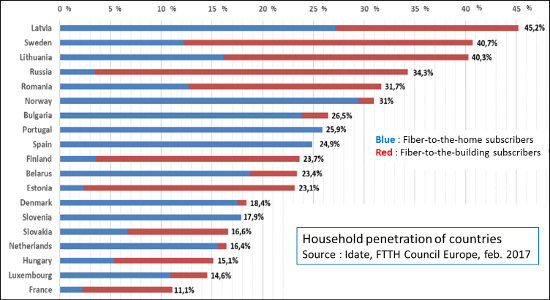FTTH Conference 2017, Marseille (France)

In Marseille (France), the FTTH Council Europe held its annual “FTTH Conference”. Three major points: a good affluence in this event, the deployment of subscribers continues and the focus is “Towards the gigabit society”.
What’s new in the FTTH domain in Europe?
Building a brighter future
Combining a high-level conference with a leading edge exhibition and unparalleled networking opportunities, this 14th edition of the FTTH Conference remains an international fiber-focused event. During three days – 14-16 February 2017 – about 3000 delegates from 84 countries have participated at 14 conference sessions and 9 workshops held by more than 150 speakers. In the exhibition center, they were around 120 exhibitors and partners who illustrated, with their products and solutions, the theme of the event: "Building a brighter future".
Deployment of subscribers
The number of FTTH subscribers is increasing and positive indicators are present. For the numbers, Idate Consulting gave these figures: at the European level, the number of fiber to the home (FTTH) and fiber to the building (FTTB) subscribers increased by 23% over the first nine months of 2016 and the number of “homes passed”1 increased by 17%. So, they were more than 44.3 million FTTH/B subscribers and nearly 148 million FTTH/B homes passed in EU39 at September 2016. In EU39, Idate Consulting noted that 17 countries have more than 2 million homes passed and 9 countries have 1 million subscribers or more: Russia, Spain, France, Romania, Sweden… On household penetration of European countries, only 12 have a mature market with a rate higher than 20% (cf. illustration). The best penetrations are for Latvia, Sweden, Lithuania, Russia, Romania, Norway… France is 19th with a rate of 11.1%.
Positive indicators were presented by Graham Finnie, an independent consultant, who insisted on the fact that line speeds continue to rise steadily, pushing network operators towards FTTH; 4k TV, smart TVs, video streaming and device proliferation. Other factors mentioned were: any incumbents have shifted strategy towards FTTH; Eastern Europe generally is leaving DSL behind; competing and collaborative building are important catalysts in many countries; technology innovation (e.g. micro trenching) is also helping to reduce costs; etc.
Towards the gigabit society
The focus topics at the heart of this 14th edition of the FTTH Conference were inspired by the new Gigabit connectivity targets and the legislative proposal for a new European telecoms rulebook by the European Commission. It was completed by the approach of new services and technologies enabled by very high capacity networks to enhance our lives. But, the main question was: at what cost? A cost model calculated the complete overlay of the EU28 countries with FTTH including 100% homes passed and 50% connected. The outstanding costs are €156 billion for the already existing fiber coverage and connections. The re-use of existing infrastructure and effective implementation can lead to further 12% cost savings and could further bring down these costs to €137 billion. More precise explanations are expected for the 15th edition of the FTTH Conference that will be held in Valencia (Spain) on 13-15 February 2018. We hope to meet you at the venue: Convention & Exhibition Center Feria Valencia!
Jean-Michel MUR, Cette adresse e-mail est protégée contre les robots spammeurs. Vous devez activer le JavaScript pour la visualiser.
1 The number of “homes passed” is the potential number of premises to which an operator has capability to connect in a service area (but the premises may or may not be connected to the network).







